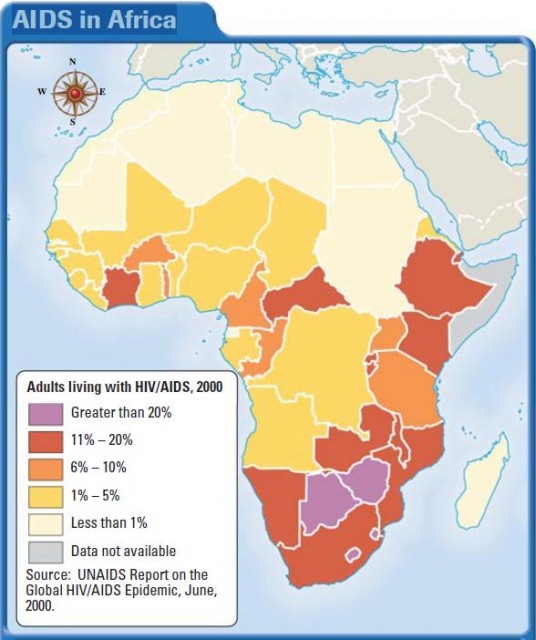Africa: Health Care
A HUMAN PERSPECTIVE On June 1, 2001, Nkosi Johnson died from the human immunodeficiency virus (HIV)—the virus that causes acquired immune deficiency syndrome (AIDS). He was the longest living South African child born with HIV. In February, he celebrated his 12th birthday—but weighed just 27 pounds. Living with a foster mother, the child had become a symbol of hope in a nation suffering from AIDS. He frankly discussed the problems of the disease and received cheers at the world's largest AIDS conference in Durban, South Africa, in July 2000. His plight was typical of many on the continent, as African nations struggle to deal with this and other diseases.
Disease and Despair
Controlling AIDS and other diseases is essential if Africans are to improve their quality of life and live a normal lifespan.
SERIOUS DISEASES
African nations are threatened by a variety of diseases. Inadequate sanitation and lack of a clean water supply can lead to cholera, an infection that is often fatal if not treated. In 2000–2001, widespread flooding caused some cases of cholera in Mozambique, but international relief efforts prevented a widespread outbreak.
Mosquitos carrying malaria—an infectious disease marked by chills and fevers that is often fatal—are common in African countries. The disease has become resistant to standard drugs because of overuse of those drugs in treating the disease during the past several decades. AIDS and HIV, however, create the most severe problems. Seventy percent of the world's adult AIDS cases and 80 percent of the world's children with AIDS are in African nations. AIDS is often accompanied by tuberculosis, a respiratory infection spread between humans.
AIDS Stalks the Continent
In 2000, AIDS took the lives of three million people worldwide. Of these, 2.4 million lived in sub-Saharan Africa. In Swaziland, three of every four deaths were attributed to AIDS. The AIDS epidemic in Swaziland has caused life expectancy there to drop from 58 years to 39 years. In 2000, nearly 26 million people in Africa were living with either HIV or AIDS.
A HIGH PRICE TO PAY
Widespread disease has economic consequences. People who are sick work less or not at all, earn less, and thus are pushed further into poverty. Economists project that by 2010, the GDP of South Africa will be 17 percent lower than it would have been if not for AIDS. Furthermore, AIDS patients' medical care is also expensive. UNAIDS, the UN program that studies the world's AIDS epidemic, estimates that $4.63 billion will be needed to fight AIDS in Africa.

Nations Respond
Response to these epidemics comes both from African nations and from countries around the world.
A VARIETY OF ANSWERS
To fight malaria and other insect-borne diseases, African nations have used spraying programs since the 1930s to reduce the number of insects. In 2000, the Global Fund for Children's Vaccines pledged more than $250 million for use over the next five years for immunization programs in Africa, Asia, Latin America, and Europe.
Some African countries are fighting disease by improving their health care systems. Gabon, for example, has used oil revenues to improve its health care system substantially. In addition, the African Development Fund approved a loan of nearly 12.3 million dollars to enable Mozambique to upgrade its public health facilities.
STRATEGIES AGAINST AIDS
Fighting and preventing AIDS is being done on many levels. In December 2000, South Africa and Brazil reached an agreement to work together on AIDS prevention and care. Brazil's public health policies to combat AIDS and other diseases are considered a model for developing countries.
SUCCESS STORIES
Two countries, Uganda and Senegal, have had success in reducing the spread of HIV. Uganda's government has spearheaded efforts to combat AIDS. For example, in 1997, Uganda began to offer same-day HIV tests and education programs. Infection rates among 15 to 24 year olds have dropped by 50 percent. On the other hand, Senegal has controlled the spread of the disease from the outset through an intensive education program. Infection rates have remained below two percent since the mid-1980s.
UNAIDS says that HIV infection rates in 2000 in sub-Saharan Africa dropped by 200,000 cases from 1999. However, UNAIDS cautions that the drop in HIV infection rates could mean that almost as many people are dying of AIDS as are being infected with HIV. Nevertheless, many African nations are taking action. With these efforts, African countries can build an effective health care system and make progress against the epidemics that threaten its peoples and cultures.